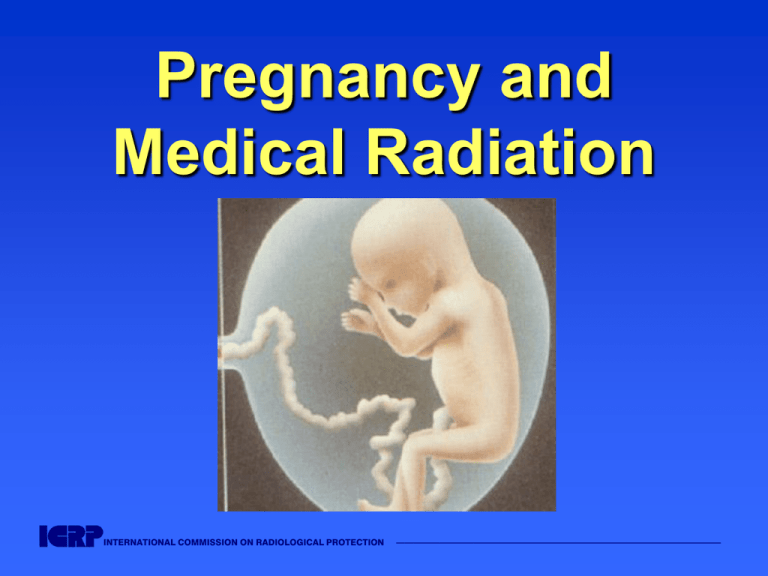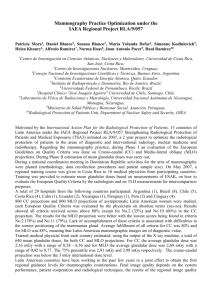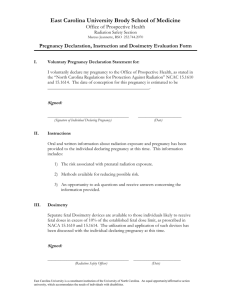Pregnancy: ICRP P84
advertisement

Pregnancy and Medical Radiation INTERNATIONAL COMMISSION ON RADIOLOGICAL PROTECTION —————————————————————————————————————— International Commission on Radiological Protection Information abstracted from ICRP Publication 84 Available at www.icrp.org Task Group: R. Brent, F. Mettler, L. Wagner, C. Streffer, M. Berry, S. He, T. Kusama INTERNATIONAL COMMISSION ON RADIOLOGICAL PROTECTION —————————————————————————————————————— Use and disclaimer This is a PowerPoint file It may be downloaded free of charge It is intended for teaching and not for commercial purposes This slide set is intended to be used with the complete text provided in ICRP Publication 84 INTERNATIONAL COMMISSION ON RADIOLOGICAL PROTECTION —————————————————————————————————————— Contents Introduction Fetal radiation risks Informed consent, notices, pregnancy determination Fetal doses from procedures Pregnant workers Research involving radiation during pregnancy Issues regarding termination of pregnancy INTERNATIONAL COMMISSION ON RADIOLOGICAL PROTECTION —————————————————————————————————————— Introduction Thousands of pregnant women are exposed to ionising radiation each year Lack of knowledge is responsible for great anxiety and probably unnecessary termination of pregnancies For most patients, radiation exposure is medically appropriate and the radiation risk to the fetus is minimal INTERNATIONAL COMMISSION ON RADIOLOGICAL PROTECTION —————————————————————————————————————— Example: justified use of CT Pregnant female, was in motor vehicle accident Fetal skull ribs Blood outside uterus Fetal dose 20 mGy 3 minute CT exam and taken to the operating room. She and the child survived Free blood Kidney torn off aorta (no contrast in it) INTERNATIONAL COMMISSION ON RADIOLOGICAL PROTECTION —————————————————————————————————————— Splenic laceration Fetal radiation risk There are radiation-related risks throughout pregnancy that are related to the stage of pregnancy and absorbed dose Radiation risks are most significant during organogenesis and in the early fetal period, somewhat less in the 2nd trimester, and least in the 3rd trimester Most risk Less Least Radiation-induced malformations Malformations have a threshold of 100-200 mGy or higher and are typically associated with central nervous system problems Fetal doses of 100 mGy are not reached even with 3 pelvic CT scans or 20 conventional diagnostic xray examinations These levels can be reached with fluoroscopically guided interventional procedures of the pelvis and with radiotherapy INTERNATIONAL COMMISSION ON RADIOLOGICAL PROTECTION —————————————————————————————————————— Central nervous system effects During 8-25 weeks post-conception the CNS is particularly sensitive to radiation Fetal doses in excess of 100 mGy can result in some reduction of IQ (intelligence quotient) Fetal doses in the range of 1000 mGy can result in severe mental retardation and microcephaly, particularly during 8-15 weeks and to a lesser extent at 16-25 weeks INTERNATIONAL COMMISSION ON RADIOLOGICAL PROTECTION —————————————————————————————————————— Heterotopic gray matter (arrows) near the ventricles in a mentally retarded individual occurring as a result of high dose in-utero radiation exposure Frequency of microcephaly as a function of dose and gestational age occurring as a result of in-utero exposure in atomic bomb survivors (Miller 1976) Leukaemia and cancer… Radiation has been shown to increase the risk for leukaemia and many types of cancer in adults and children Throughout most of pregnancy, the embryo/fetus is assumed to be at about the same risk for carcinogenic effects as children INTERNATIONAL COMMISSION ON RADIOLOGICAL PROTECTION —————————————————————————————————————— Leukaemia and cancer (cont’d) The relative risk may be as high as 1.4 (40% increase over normal incidence) due to a fetal dose of 10 mGy For an individual exposed in utero to 10 mGy, the absolute risk of cancer at ages 015 is about 1 excess cancer death per 1,700 INTERNATIONAL COMMISSION ON RADIOLOGICAL PROTECTION —————————————————————————————————————— Probability of bearing healthy children as a function of radiation dose Dose to conceptus (mGy) above natural background Probability of no malformation Probability of no cancer (0-19 years) 0 97 99.7 1 97 99.7 5 97 99.7 10 97 99.6 50 97 99.4 100 97 99.1 >100 Possible, see text Higher Pre-conception irradiation Pre-conception irradiation of either parent’s gonads has not been shown to result in increased risk of cancer or malformations in children This statement is from comprehensive studies of atomic bomb survivors as well as studies of patients who had been treated with radiotherapy when they were children INTERNATIONAL COMMISSION ON RADIOLOGICAL PROTECTION —————————————————————————————————————— Informed consent and understanding The pregnant patient or worker has a right to know the magnitude and type of potential radiation effects that might result from in-utero exposure Communication should be related to the level of risk. Communication that risk is negligible is adequate for very low dose procedures (<1 mGy to the fetus) If fetal doses are above 1 mGy, a more detailed explanation should be given INTERNATIONAL COMMISSION ON RADIOLOGICAL PROTECTION —————————————————————————————————————— Exposure of pregnant patients In some circumstances, the exposure is inappropriate and the unborn child may be at increased risk of harm to health Prenatal doses from most properly performed diagnostic procedures present no measurably increased risk of prenatal death, malformation, or mental impairment Higher doses such as those from therapeutic procedures can result in significant fetal harm INTERNATIONAL COMMISSION ON RADIOLOGICAL PROTECTION —————————————————————————————————————— Medical radiation procedures All medical practices (occupational and patientrelated) should be justified (more benefit than risk) Medical exposures should be justified for each patient before they are performed After it is decided to do a medical radiation procedure, the fetal radiation dose should be reduced while still obtaining the required diagnostic information INTERNATIONAL COMMISSION ON RADIOLOGICAL PROTECTION —————————————————————————————————————— Evaluation of potentially pregnant patients In females of child-bearing age, an attempt should be made to determine who is, or could be, pregnant, prior to radiation exposure INTERNATIONAL COMMISSION ON RADIOLOGICAL PROTECTION —————————————————————————————————————— Notices A missed period in a regularly menstruating woman should be considered due to pregnancy, until proven otherwise Notices regarding pregnancy should be posted in patient waiting areas, such as If it is possible that you might be pregnant, notify the physician or other staff before your xray examination, treatment, or before being injected with a radioactive material INTERNATIONAL COMMISSION ON RADIOLOGICAL PROTECTION —————————————————————————————————————— Approximate fetal doses from conventional x-ray examinations Data from the UK, 1998 Dose Examination Abdomen Chest Mean (mGy) Maximum (mGy) 1.4 4.2 <0.01 <0.01 Intravenous urogram; lumbar spine 1.7 10 Pelvis 1.1 4 <0.01 <0.01 Skull; thoracic spine Approximate fetal doses from fluoroscopic and computed tomography procedures Data from the UK, 1998 Dose Examination Mean (mGy) Barium meal (UGI) 1.1 Barium enema 6.8 Maximum (mGy) 5.8 24 Head CT <0.005 <0.005 Chest CT 0.06 1.0 Abdomen CT 8.0 Pelvis CT 25 49 80 Higher dose procedures Radiation therapy and interventional fluoroscopically-guided procedures may give fetal doses in the range of 10-100 mGy or more depending on the specifics of the procedure After such higher dose medical procedures have been performed on pregnant patients, fetal dose and potential fetal risk should be estimated by a knowledgeable person INTERNATIONAL COMMISSION ON RADIOLOGICAL PROTECTION —————————————————————————————————————— Nuclear medicine and pregnant patients… Most diagnostic procedures are done with shortlived radionuclides (such as technetium-99m) that do not cause large fetal doses Often, fetal dose can be reduced through maternal hydration and encouraging voiding of urine Some radionuclides do cross the placenta and can pose fetal risks (such as iodine-131) INTERNATIONAL COMMISSION ON RADIOLOGICAL PROTECTION —————————————————————————————————————— Nuclear medicine and pregnant patient (cont’d) The fetal thyroid accumulates iodine after about 10 weeks gestational age High fetal thyroid doses from radioiodine can result in permanent hypothyroidism If pregnancy is discovered within 12 h of radioiodine administration, prompt oral administration of stable potassium iodine (60-130 mg) to the mother can reduce fetal thyroid dose. This may need to be repeated several times INTERNATIONAL COMMISSION ON RADIOLOGICAL PROTECTION —————————————————————————————————————— Approximate whole body fetal dose (mGy) from common nuclear medicine procedures Activity (MBq) Early pregnancy 9 months 750 240 4.7 0.9 1.8 0.9 Liver colloid scan Thyroid scan 300 400 0.6 4.4 1.1 3.7 Renal DTPA Red blood cell 300 930 9.0 6.0 3.5 2.5 30 0.6 0.3 0.04 0.15 Procedure Tc-99m Bone scan Lung scan I-123 thyroid uptake I-131 thyroid uptake 0.55 Nuclear medicine and breast feeding A number of radionuclides are excreted in breast milk. It is recommended that breast feeding is suspended as follows: – Completely after 131I therapy – 3 weeks after 131I, 125I, 67Ga, 22Na, and 201Tl – 12 h after hippurate and all except as below 131I – 4 h after 99mTc 99mTc compounds red cells, DTPA, and phosphonates INTERNATIONAL COMMISSION ON RADIOLOGICAL PROTECTION —————————————————————————————————————— Research on pregnant patients Research involving radiation exposure of pregnant patients should be discouraged INTERNATIONAL COMMISSION ON RADIOLOGICAL PROTECTION —————————————————————————————————————— Radiation exposure of pregnant workers Pregnant medical radiation workers may work in a radiation environment as long as there is reasonable assurance that the fetal dose can be kept below 1 mGy during the pregnancy 1 mGy is approximately the dose that all persons receive annually from penetrating natural background radiation INTERNATIONAL COMMISSION ON RADIOLOGICAL PROTECTION —————————————————————————————————————— Termination of pregnancy… High fetal doses (100-1000 mGy) during late pregnancy are not likely to result in malformations or birth defects since all the organs have been formed A fetal dose of 100 mGy has a small individual risk of radiation-induced cancer. There is over a 99% chance that the exposed fetus will NOT develop childhood cancer or leukaemia INTERNATIONAL COMMISSION ON RADIOLOGICAL PROTECTION —————————————————————————————————————— Termination of pregnancy (cont’d) Termination of pregnancy at fetal doses of less than 100 mGy is NOT justified based upon radiation risk At fetal doses in excess of 500 mGy, there can be significant fetal damage, the magnitude and type of which is a function of dose and stage of pregnancy At fetal doses between 100 and 500 mGy, decisions should be based upon individual circumstances INTERNATIONAL COMMISSION ON RADIOLOGICAL PROTECTION —————————————————————————————————————— Risks in a pregnant population not exposed to radiation Risks: - Spontaneous abortion > 15% - Incidence of genetic abnormalities 4-10% - Intrauterine growth retardation 4% - Incidence of major malformation 2-4% INTERNATIONAL COMMISSION ON RADIOLOGICAL PROTECTION —————————————————————————————————————— Web sites for additional information on radiation sources and effects European Commission (radiological protection pages): europa.eu.int/comm/environment/radprot International Atomic Energy Agency: www.iaea.org International Commission on Radiological Protection: www.icrp.org United Nations Scientific Committee on the Effects of Atomic Radiation: www.unscear.org World Health Organization: www.who.int INTERNATIONAL COMMISSION ON RADIOLOGICAL PROTECTION ——————————————————————————————————————








